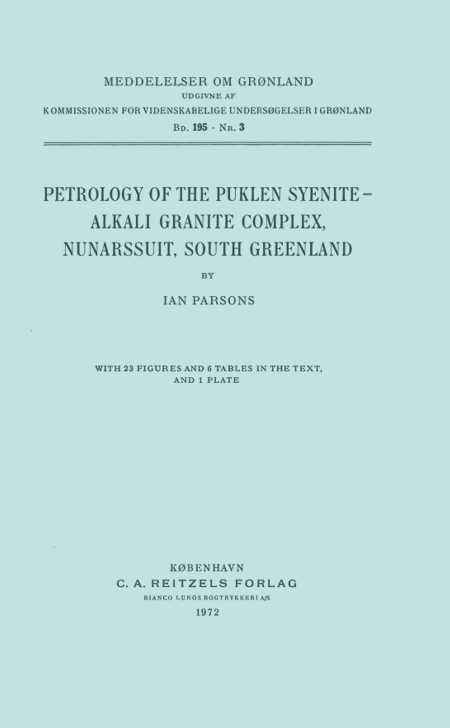Petrology of the Puklen Syenite-Alkali Granite Complex, Nunarssuit, South Greenland.
DOI:
https://doi.org/10.7146/mog.v195.148981Abstract
The Puklen complex (PULVERTAFT, 1963) has been studied with a view to comparison with the larger adjacent Nunarssuit syenite. It comprises augite syenites, quartz syenites, often pegmatitic in type, a transition group of quartzose syenites and quartz-poor granites, a relatively large alkali granite body, and cross-cutting microgranites. Modal quartz increases continuously from syenite to soda granite. A sodic vapour phase was entrapped in the drusy quartz syenites; their textures contrast with the even textured transition group syenites which grade into soda granite. Mineral layering is seen in the transition group. Pyroxenes in the quartz syenites are strongly zoned aegirine-augites; in the transition group they are less strongly zoned but have similar bulk compositions.
The transition to granite is marked by appearance of riebeckite-arfvedsonite as the dominant mafic mineral, by late crystallizing acmitic pyroxene, and by astrophyllite, aenigmatite and biotite. The potassium-rich phase in the microperthitic alkali feldspars varies from dominant orthoclase in the coarse augite syenites, orthoclase + microcline in the quartz syenites and transition group, and microcline alone in the soda granites and microgranites. The variation is attributed to the increasing peralkalinity of the magma. The rocks plot near thermal minima in the Ab-Or-Qz system. The effect of anorthite, peralkalinity and acmite on this system are discussed. The granites crystallized at PH,O < 1 Kbar and at temperatures > 780° C. Quartz-feldspar textures are discussed and the granophyric intergrowths (mainly in the microgranites but also in certain layered rocks) are ascribed to a pressure reduction. The intrusion involved two main magmatic pulses; a slightly oversaturated syenite and a soda granite lying in the feldspar field in the Ab-Or-Qz system. Both have fractionated to some extent in situ.

Downloads
Published
How to Cite
Issue
Section
License
Coypyright by the authors and the Commision for Scientific Research in Greenland. No parts of the publications may be reproduced in any form without the written permission by the copyright owners.

